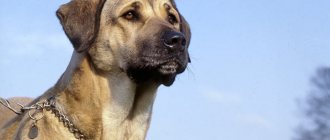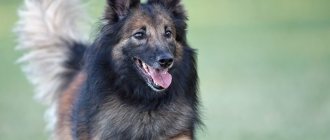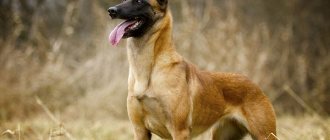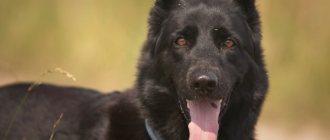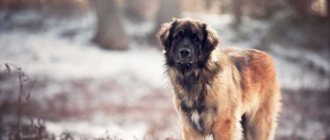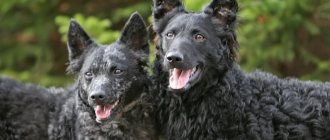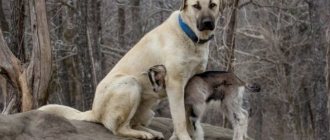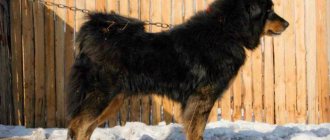| Origin: | Türkiye |
| Usage: | protection of livestock and territory |
| Color: | any |
| Dimensions: | height 74-81 cm, weight 45-60 kg |
| Lifespan: | 12-15 years |
A real Turkish treasure is the Kangal, or Anatolian Shepherd Dog. This guard and herding dog breed is not suitable for beginners. Only an experienced dog breeder can handle them. The owner will have to find a special approach to the animal and take the place of leader in the pack. However, keeping Kangals is not at all difficult. It is much more difficult to educate them into a courageous and brave assistant.
Breed characteristics
| Short description | |
| Origin: | Türkiye |
| Conditions of detention: | In a house with a large area |
| Purpose: | Shepherd dog, guard dog |
| Color: | Gray-yellow, brownish-yellow, gray-brown |
| Wool length: | From 2 cm to 13 cm |
| Adult dog size: | The height of females is 70-80 cm, males 75-85 cm, weight of males is approximately 52 - 64 kg, females - 43-60 kg. |
| Average life expectancy: | 12 years |
| Walk: | Three meals a day are required |
| Physical activity needs: | High. Walk for at least three hours every day |
| Fédération Cynologique Internationale (FIC) classification: | FCI: Group 2: Pinschers and Schnauzers, Molossians, Mountain Dogs. Section 2: Molossians |
| Puppy price: | From 35,000 rub. without documents, puppy with pedigree – 125,000-300,000 rubles |
History of the origin of the species
There are many hypotheses regarding the place of existence of the first Kangals. According to experts, this breed appeared about 6,000 years ago and is the direct ancestor of the Anatolian Shepherd, but the international kennel club recognized it only in 1990. Now Karabash is a service dog that belongs to the Molosser group. Its development occurred independently, without human intervention.
There is a long-standing legend that for the first time a dog from the Karabashi breed was brought to the padishah of the Ottoman Empire as a gift from the Indian people. But the dog ran away and got lost in the vicinity of Kangal, a city in Turkey. The term “Karabash” itself is translated as “black-headed” or “black head”.
There is also a theory that this breed was developed in ancient Babylon. It was used as a fighting dog in the active army or as a hunting dog for especially large prey: lions, wolves, horses.
According to official information, the place of origin of the Anatolian Shepherd is the settlement of the peoples of Turkmenistan in Kangal. Its direct ancestors are the ancient breeds - Kangal and Akbashi.
Purebred Karabashi are a Turkish heritage. The export of these dogs from the country is strictly prohibited. Individuals for reproduction undergo strict selection, and the slightest deviations from the norms deprive the dog of the “purity” of the breed. However, all “rejected” puppies can be transported to any country. At the moment they are very popular in Europe and America.
Interesting Facts
- The breed is currently recognized as a national treasure of Turkey, it can be seen on advertising brochures, badges, among souvenirs and on coins. In some Turkish families, there is a custom to give the family a Karabash puppy for the birth of their first child.
- Shepherds often tell stories that Kangal Shepherds, when they find a sheep, selflessly protect it for several days, going without food or drink.
- In Namibia and Kenya, Kangal Shepherds are used to protect livestock from cheetahs. And the cheetah, for your information, is the fastest predator on the planet. Where these dogs have been employed, livestock losses have been significantly reduced.
- The protective coloring of the karabash had another amazing feature. Thanks to such wool, the dog did not frighten the sheep with its appearance, to the point that they allowed it to nurse their lambs.
- Ear cropping of a Kangal Shepherd is considered illegal in some countries, such as the UK.
- Anatolian Shepherds often choose a place on a hill to survey the surroundings, and they generally try to lead the family pack. The Kangal may not accept a second large dog, but a small dog or any other animal will be protected and loved.
Distinctive features
There is no official world standard for the size of the Anatolian Shepherd. In each individual country that has a patent for breeding these dogs, the height at the withers and weight vary.
In Turkey, a height of 65-78 cm is considered normal for the breed , and the size difference between females and males is not prescribed. In Great Britain, the standard “height” for a male is 74-81 cm , and for a female – 71-79 cm . In the USA and New Zealand: the boy’s height is 74-82 cm , and his weight is 50-66 kg ; The girl’s height is 71-76 cm and her weight is 41-54 kg.
Criteria for selecting purebred dogs:
- The head is large, rectangular in shape, with a rounded forehead. The skull should be proportional to the body. The muzzle is square.
- The jaws are strong with large, strong teeth and form a scissor bite.
- The eyes are set wide. They have a pronounced almond-shaped or triangular shape. They can be medium or small in size. The dog's gaze is concentrated and serious. The iris is brown or amber.
- The nose may be black or brown (depending on the coat). The nostrils are oval and open.
- The ears are medium in size. Shaped like an inverted triangle. In a dog's normal calm state, the ears hang down. If Karabash is tense, then they fit tightly to the head and rise. They are often stopped to protect the animal in fights and improve hearing.
- The neck is wide, muscular, and has a dewlap from the chest.
- The body is a proportional, streamlined rectangle. The neck smoothly transitions into a flat, wide back. The stomach is tucked.
- The tail is carried high and curled in a ring. Has fluffy fur.
- The legs are straight, strong and muscular. The rear ones are slightly more massive than the front ones. They have oval pads, strong claws with black pigment.
- coat can be of three colors: gray-yellow, brown-yellow or gray-brown. A distinctive feature is the black markings on the face and ears. In length there are short-haired (2 cm) and long-haired (14 cm). They have a dense undercoat that warms in the cold and protects from the heat.
Photo of an adult dog
Photos of puppies
Features of character and behavior
Karabash is best suited for an experienced dog breeder or dog handler. Despite his flexible nature, he will never submit and will not serve a person in whom he sees weakness. These dogs are smart, brave and loyal, but they will demand the same from their owner.
Advantages
In the conditions of centuries-old development and service to people, Karabash acquired many qualities necessary for a working breed.
- Strength and protective instincts. The shepherd's muscles are so highly developed that when protecting the herd, the dog can easily strangle a wolf. If this happens, in Turkey it is customary to slaughter a ram in honor of the dog.
- Devotion . Karabashi are modest in their emotions, but their big heart will belong only to their owners. He quickly gets acquainted with the house, family members, the territory entrusted to him to guard, and will protect all this at the cost of his life. Treats strangers with suspicion and coldness. He treats children as little sheep that need to be protected; Karabash is considered a good nurse.
- Speed and physical development. These dogs are not used to sitting idle, so they need a large area to walk and run. He can easily catch up with a lion without looking at his size.
- Endurance . The thick coat and undercoat helps the Anatolian to withstand severe frost and scorching sun.
- Independence . Shows self-sufficiency in everything. The strong character of the dog is difficult to break, since it was originally a hunter and fighter
- Seriousness . Any signal from your pet will mean something. If she barks heart-rendingly, she warns the owner against something. Also, Anatolians do not damage property; they are not interested in that.
Karabashi have a stable psyche and are not prone to sudden changes in mood with proper care. Aggression is not characteristic of this dog, despite the fact that it is considered a shepherd.
Flaws
Basically, the breed has practically no disadvantages. But due to the strong-willed nature, there are some nuances. Karabashi do not accept another large dog on their territory, especially if it is a male. The dog will try to show his leadership qualities and may become aggressive.
Shepherds are also not playful. If the owner wants to play with the dog, Karabash will not understand this. He prefers running in spacious areas. Modesty in emotions can also be considered a shortcoming. Anatolians are not able to react violently to anything, to be happy or sad.
Nutrition
The easiest way is to choose ready-made extra-class or holistic food, which provides the necessary microelements and a balanced menu. If you decide to feed natural food, follow some rules. There is no need to give fatty, floury, spicy, salty and sweet foods. The dog should not experience problems with the stomach, teeth and heart.
The best options are boiled lean meat and boneless fish, as well as cereal porridge in broth with the addition of vegetable oil. Include more dairy products, it is good for bones. Give vitamins and fiber in the form of vegetables. Potatoes and pasta are allowed no more than once a week. Sometimes you can have a raw egg or fruit.
Don't forget to pamper your pet with a large bone. Regarding nutrition, consult your veterinarian, he will help you create a balanced diet. An important rule that should never be broken is that the water bowl must always be clean and filled.
Care and maintenance
Although Karabash is an unpretentious dog, it is not recommended for an inexperienced breeder to start with such a pet. Dog training needs to be clearly planned and done from puppyhood. Anatolians have skills in their genes, but behavior depends on regular training. Karabash will consider every command of the owner: the older the dog, the more difficult it is to convince him of the need for exercise.
Nutrition
This breed is not picky about food. But it is important to consider the main components of the diet necessary for the healthy development of a pet:
- Various cereals - cereals ;
- vegetables and fruits in porridges ;
- Lean meat products of several types.
If dry food is preferable, then premium and super-premium food is acceptable. With the obligatory addition of special vitamins and calcium supplements.
It is not recommended to mix several types of feeding (dry and natural). Also, it is better to check with the breeder what the puppy was fed before purchase, because... A sudden change in diet can have a negative impact on your pet’s health.
Anatolians have a tendency towards obesity. Therefore, you cannot overfeed them. Puppies are usually fed 3-4 times a day, and adults - 2 times. The daily food intake for a dog is 20% of its weight. However, in the cold season, portions need to be increased.
Health
This breed is built like a real winner - strong strong paws, powerful skeleton and jaws. But due to its large size and weight, the dog may develop diseases of the joints and bones. This occurs when there is a lack of calcium in the body.
Puppies are fully mature by 18 months. The dog's immunity develops quite slowly, so Karabashi is in dire need of vaccinations.
Vaccinations
Vaccination is necessary for dogs of all breeds. Anatolians are no exception. Vaccinations must be performed regularly. 2 weeks before the procedure, it is necessary to carry out a deworming procedure (getting rid of worms). List of necessary vaccinations for Karabash:
- Complex vaccination (hepatitis, plague, leptospirosis, enteritis, influenza). Age – 1.5 months. The animal must be kept in quarantine for 14 days.
- Second complex vaccination . Age – 3 months . Quarantine 14 days , walking without contact with other pets is allowed.
- Against rabies . Age – 6 months . It is necessary to vaccinate every year.
- Complex vaccination . Age – 7 months .
- Complex vaccination. Age – 12 months . Further vaccination is carried out once a year.
Quarantine after vaccination is important for the final development of immunity against the disease. In the first days after vaccination, the pet is susceptible to viruses.
Diseases
Karabash’s health is enviable, but he also has chronic diseases:
- Dysplasia of the knee, elbow and hip joints. This occurs if the pet is insufficiently active, overweight or lacks calcium. Although most often this disease is hereditary.
- With dysplasia, a dog's gait changes and joints swell. Karabash cannot run or climb stairs. There is lameness.
- The Anatolian Shepherd also suffers from eye diseases: ectropion and entropion.
Walk
Keeping in an apartment or on a chain is unacceptable for this breed. The Karabashi lived for many years without human intervention; they were accustomed to existing in open mountainous areas. The best place for a dog would be a house with a large surrounding area and high fencing necessary to protect passers-by. A free entrance to the premises or a large booth to shelter the dog is required.
Dog handlers recommend walking your dog, even if it lives in the courtyard of a private house. They need communication with other pets and people, it will instill rules of behavior. The duration of the walk is 2 hours. Frequency – 2-3 times a day.
Grooming
As already mentioned, dogs do not respond to climate change, which allows them to be kept in both southern and northern countries. Twice a year there is heavy shedding, during this period you need to comb your pet often, in other seasons the frequency of combing is 2-3 times a week . It is best to use a stiff brush.
This breed has virtually no odors, so it does not need daily bathing, but it is important to examine the ears and mouth. As a rule, Karabashi are washed once a month. Do not use regular shampoos intended for humans.
It is important not to forget to brush your pet’s teeth and periodically trim its nails with special devices.
Health
The Kangal breed dog is adapted to live in a harsh climate, so its health can only be envied. It is resistant to most common diseases, is not susceptible to stress, and easily tolerates temperature changes and changes in environment.
Diseases
Anatolian Shepherds have strong immunity. However, in rare cases, you may experience:
- entropion (turning of the eyelids);
- joint diseases due to the large mass of the animal.
With proper care and regular visits to the veterinarian, Kangals do not have any health problems.
Vaccinations
At two and three months of age, Anatolian Shepherd puppies are vaccinated with complex vaccines, and at six months of age - against rabies. In the future, they are vaccinated in the same way as other large breed dogs. Do not forget to regularly carry out anthelmintic and anti-tick treatments.
Kangal puppies are kept in quarantine until all vaccinations are completed.
Mating
Since Anatolian Shepherds develop quickly, they become capable of breeding already at 8-12 months. It is believed that this age is early, the dog’s body will not be able to conceive, bear and give birth to strong offspring. Therefore, it is recommended to do the first mating at 20 months for females and at 24 months for males. Physiologically, the female is capable of breeding on the 3rd estrus .
It is recommended to bring dogs together in the male's territory. There he will feel like a master, which will help the dog to be more active.
Application
The Turkish Kangal was bred as a livestock guard dog. In their homeland, these dogs are still used for their intended purpose. At the same time, the Anatolian Shepherd is an excellent watchdog. The owner can be calm - she will never allow strangers to enter her territory.
However, the Kangal does not consider humans an enemy. When a stranger enters, he uses his voice to indicate his presence, awaiting the reaction of the uninvited guest. If he stops and walks away, the dog will not touch him.
Key points in training
Karabashi are born leaders, they are willful and tend to dominate. Training should start from early childhood. In the first few months of life, it is difficult to attract the puppy's attention to activities. They are self-sufficient and do not need praise.
- Most often, the method of motivation is used in training Anatolians.
- You cannot show aggression, harshly punish or beat your pet. Otherwise, the dog will adopt this behavior and stop trusting you.
- The key to successful training is to make friends with Karabash. The most serious punishment can be a ban on food, but this is only as a last resort.
- It is enough for the Anatolian Shepherd to explain the tasks, to show how they should and should not behave.
- Read about how to properly train a dog in the article: “Training a puppy: effective methods from dog handlers, learning commands at home.”
In the absence of training, Karabash can become aggressive and attack people and animals. These dogs, cute at first glance, become “hunting machines” in the wild.
How to choose a puppy
Officially, the export of this breed from Turkey is prohibited. But in Europe, America and Russia there are official clubs and breeders who breed Anatolian Shepherds. You should not take risks and buy puppies “from hand to hand”. Such a sale does not guarantee the good health and stable psyche of the baby.
- If a dog is purchased for exhibition, it must be carefully examined.
It must meet the standards. The more matches with official characteristics, the higher the chances of winning competitions. - Before purchasing, talk to the breeders, find out about the conditions in which the puppy is kept and its diet . Ask to see your parents, if possible both. Based on their behavior, it will be possible to determine the potential character and future size of the puppy.
- Externally, puppies should be clean, with shiny fur and eyes. Under normal conditions, dogs will be playful, curious and active. Evaluate everyone's reaction to your presence; if someone from the litter shows obvious interest, you have found your friend.
- Prices for puppies vary from 30,000 rubles to 300,000 rubles . It all depends on the pedigree, the “standard” of the parents and the officiality of the breeder. The most expensive puppy will be the one born as a champion.
It is worth saying that this breed is not for everyone. The Anatolian Shepherd is not a companion, but a faithful friend. She will be faithful to her master until death, but will require the same attitude.
5 / 5 ( 1 voice )
Price
Anatolian karabash is not a cheap pleasure and is quite rare. We strongly advise against purchasing a puppy at a poultry market, although even there a dog will cost about 30,000 rubles. For private breeders, the price is set from 40,000 to 50,000 rubles. Babies with minor defects (non-standard color, white spots on the body, too long hair) are much cheaper.
There are also breeding nurseries on the territory of the Russian Federation - monobreed or complex breeding. The price of a pure breed Anatolian Shepherd in a kennel is approximately 65,000-70,000 rubles, and an “elite class” puppy will cost 120,000-130,000 rubles. Another piece of advice – when choosing a puppy, rely on the opinion of a respected specialist.
